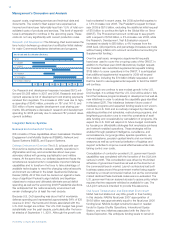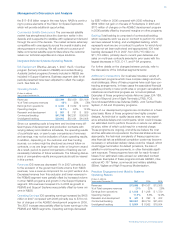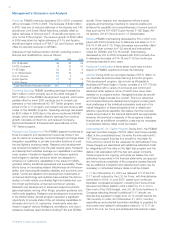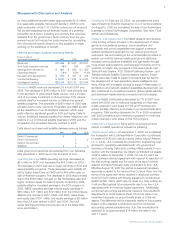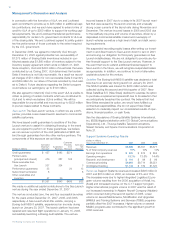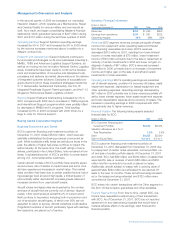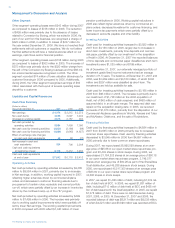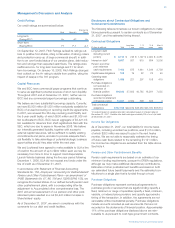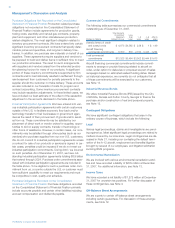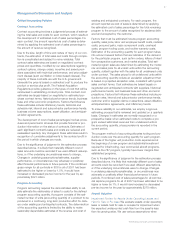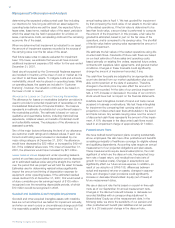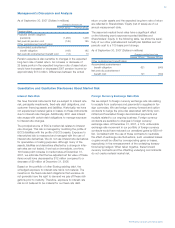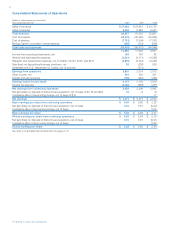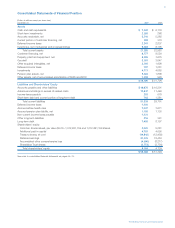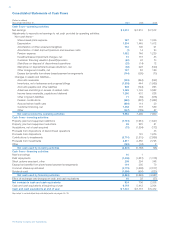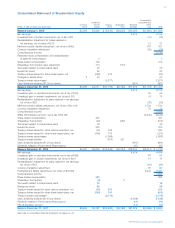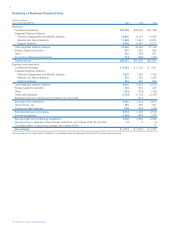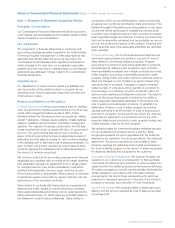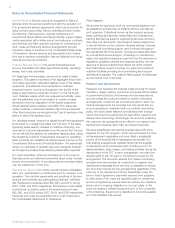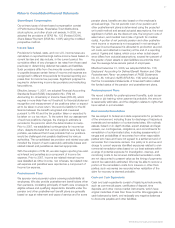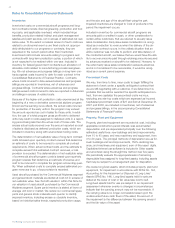Boeing 2007 Annual Report Download - page 41
Download and view the complete annual report
Please find page 41 of the 2007 Boeing annual report below. You can navigate through the pages in the report by either clicking on the pages listed below, or by using the keyword search tool below to find specific information within the annual report.38
Management’s Discussion and Analysis
determining the expected undiscounted cash flow including
our intentions for how long we will hold an asset subject to
operating lease before we sell the asset, the expected future
lease rates, lease terms, residual value of the asset, periods in
which the asset may be held in preparation for a follow-on
lease, maintenance costs, remarketing costs and the remaining
economic life of the asset.
When we determine that impairment is indicated for an asset,
the amount of impairment expense recorded is the excess of
the carrying value over the fair value of the asset.
Had future lease rates on assets evaluated for impairment
been 10% lower, we estimate that we would have incurred
additional impairment expense of $6 million for the year ended
December 31, 2007.
Used aircraft acquired by the Commercial Airplanes segment
are included in Inventory at the lower of cost or market as it is
our intent to sell these assets. To mitigate costs and enhance
marketability, aircraft may be placed on operating lease. While
on operating lease, the assets are included in ‘Customer
financing’, however, the valuation continues to be based on
the lower of cost or market.
Allowance for Losses on Customer Financing Receivables
The allowance for losses on receivables (valuation provision) is
used to provide for potential impairment of receivables on the
Consolidated Statements of Financial Position. The balance
represents an estimate of probable but unconfirmed losses in
the receivables portfolio. The estimate is based on various
qualitative and quantitative factors, including historical loss
experience, collateral values, and results of individual credit
and collectibility reviews. The adequacy of the allowance is
assessed quarterly.
Two of the major factors influencing the level of our allowance
are customer credit ratings and collateral values. If each cus-
tomer’s credit rating were increased or decreased by one
major rating category at December 31, 2007, the allowance
would have decreased by $22 million or increased by $49 mil-
lion. If the collateral values were 10% lower at December 31,
2007, the allowance would have increased by $27 million.
Lease Residual Values Equipment under operating leases is
carried at cost less accumulated depreciation and is depreciat-
ed to estimated residual value using the straight-line method
over the period that we project we will hold the asset for lease.
Estimates used in determining residual values significantly
impact the amount and timing of depreciation expense for
equipment under operating leases. If the estimated residual
values declined 5% at December 31, 2007, this would result in
a future cumulative pre-tax earnings impact of $105 million
recognized over the remaining depreciable periods, of which
$10 million would be recognized in 2008.
Goodwill and Indefinite-Lived Intangible Impairments
Goodwill and other acquired intangible assets with indefinite
lives are not amortized but are tested for impairment annually,
and when an event occurs or circumstances change such that
it is reasonably possible that an impairment may exist. Our
annual testing date is April 1. We test goodwill for impairment
by first comparing the book value of net assets to the fair value
of the related operations. If the fair value is determined to be
less than book value, a second step is performed to compute
the amount of the impairment. In this process, a fair value for
goodwill is estimated, based in part on the fair value of the
operations, and is compared to its carrying value. The shortfall
of the fair value below carrying value represents the amount of
goodwill impairment.
We estimate the fair values of the related operations using dis-
counted cash flows. Forecasts of future cash flows are based
on our best estimate of future sales and operating costs,
based primarily on existing firm orders, expected future orders,
contracts with suppliers, labor agreements, and general market
conditions. Changes in these forecasts could significantly
change the amount of impairment recorded, if any.
The cash flow forecasts are adjusted by an appropriate dis-
count rate derived from our market capitalization plus a suit-
able control premium at the date of evaluation. Therefore,
changes in the stock price may also affect the amount of
impairment recorded. At the date of our previous impairment
test, a 10% increase or decrease in the value of our common
stock would have had no impact on the financial statements.
Indefinite-lived intangibles consist of brand and trade names
acquired in business combinations. We test these intangibles
for impairment by comparing their carrying value to current
projections of discounted cash flows attributable to the brand
and trade names. Any excess carrying value over the amount
of discounted cash flows represents the amount of the impair-
ment. A 10% decrease in the discounted cash flows would
result in an impairment charge of approximately $11 million.
Postretirement Plans
We have defined benefit pension plans covering substantially
all our employees. We also have other postretirement benefits
consisting principally of healthcare coverage for eligible retirees
and qualifying dependents. Accounting rules require an annual
measurement of our projected obligations and plan assets.
These measurements require several assumptions, the most
significant of which are the discount rate, the expected long-
term rate of asset return, and medical trend rate (rate of
growth for medical costs). Changes in assumptions can
significantly affect our future annual expense. In addition, as
result of our adoption of SFAS 158, differences between
actual and expected returns on assets, changes in assump-
tions, and changes in plan provisions could significantly
increase or decrease Shareholders’ Equity (net of taxes) at
future measurement dates.
We use a discount rate that is based on a point-in-time esti-
mate as of our September 30 annual measurement date.
Changes in the discount rate will increase or decrease our
recorded liabilities with a corresponding adjustment to
Shareholders’ Equity as of the measurement date. In the
following table, we show the sensitivity of our pension and
other postretirement benefit plan liabilities and net periodic
cost to a 25 basis point change in the discount rate.
The Boeing Company and Subsidiaries


